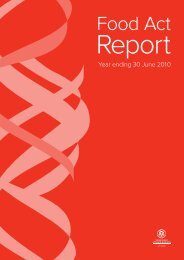Public Health and Communicable Diseases - SA Health - SA.Gov.au
Public Health and Communicable Diseases - SA Health - SA.Gov.au
Public Health and Communicable Diseases - SA Health - SA.Gov.au
You also want an ePaper? Increase the reach of your titles
YUMPU automatically turns print PDFs into web optimized ePapers that Google loves.
Sexually transmittedinfections in CentralAustralia – time forconcerted actionFigure 2: Nationwide chlamydia notifications over 5years by year <strong>and</strong> State/TerritoryAhmed S. Latif, Kirsty S. SmithTristate STI/HIV Project, CDC, Sexual <strong>Health</strong> <strong>and</strong> BloodBorne Viruses UnitIntroductionSexually transmitted infections (STIs) are an importantpublic health problem not only bec<strong>au</strong>se they can c<strong>au</strong>seserious short term <strong>and</strong> long term complications butalso bec<strong>au</strong>se they facilitate the transmission of humanimmunodeficiency virus (HIV) infection. Indigenouscommunities in Central Australia continue to experiencehigh rates of STIs including chlamydial infection,gonorrhoea, syphilis, trichomoniasis <strong>and</strong> genital herpes.Interventions for STI control in the region in the lastdecade have focussed on primary <strong>and</strong> secondaryprevention of infection through screening <strong>and</strong> casefinding <strong>and</strong> have had limited effect. An examinationof the national notification rates of chlamydial <strong>and</strong>gonococcal infection reveals extremely high annualisedinfection rates in the Northern Territory (NT). While ratesof infection of chlamydia <strong>and</strong> gonorrhoea in the rest ofAustralia are 200 per 100,000 or less, rates in the NTare more than three times greater 1 (Figures 1 <strong>and</strong> 2).Recognising the association between STIs <strong>and</strong> HIVtransmission, the World <strong>Health</strong> Organisation advises thatSTI management <strong>and</strong> control should form an integralpart of AIDS/HIV control programs globally 2 .Prevalence of STIs in the Central Australian CrossborderregionWithin the NT, STI rates are higher in the Alice Springsregion <strong>and</strong> most STI notifications in this region are fromindigenous communities in the area <strong>and</strong> from AliceSprings itself. 3, 4 The annual community based STI screenconducted over a 6-week period in 2005 revealed thatof 721 men aged between 14 <strong>and</strong> 35 years screened,119 (16.5%) had chlamydia <strong>and</strong>/or gonorrhoea <strong>and</strong>/orsyphilis, <strong>and</strong> of 808 women in the same age range, 177(21.9%) had an STI (Table 1).Table 1: Results of STI Screening in 2005 in remotecommunities in the Central Australian region of NTFigure 1: Nationwide gonorrhoea notifications over 5years by year <strong>and</strong> State/TerritoryThe trend of infection in NT communities is shown inFigure 3. It is noted that high rates of infection persistover the period of five years. The distribution of infectionthroughout the NT is not even. Higher rates of between25 <strong>and</strong> 33% occur in some remote communities <strong>and</strong> insome urban areas. STI control interventions includingSTI screening <strong>and</strong> treatment have been in place forsome years now in the Central Australian region.Rates of infection in the entire cross-border area arehigh, however control interventions have been moresuccessful in some areas than others. In WesternAustralia trends appear to be reducing gradually over theyears (Figure 4). Over the last 5 years In South Australiaa slight upward trend is noted, the rates of chlamydial<strong>and</strong> gonococcal infection previous to the period shownwere considerably higher (Figure 5).32
















